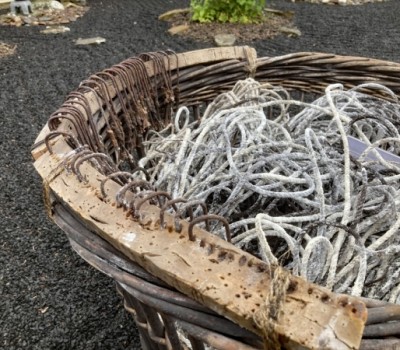Featured News
October Meeting Eden Valley Basketry Group
03 November 2025
Additions to the What's On section of the website02 November 2025
Categories
- Hepple
- General
- Etal
- Lucker
- Whitley Chapel
- Borders
- Weardale
- Cullercoats
- Tees Valley
- Broadrake
- Eden Valley
Join our Mailing List
Receive the latest news direct to your inbox by signing up below :
The Gritlin Basket
The photos show a cran, much larger than the quarter cran measure - four times larger - we are familiar with from seaside postcards and which many of us have learned from Colin Manthorpe. It is used to hold a great line, cork around the rim to protect it from the vicious fishing hooks. I have watched John Cowan make one at the Anstruther Fisheries Museum, a great skill and a beautiful basket as a result which I believe he donated to be used on a local refurbished fishing boat.
The cran was based on a barrel once used to measure a catch of fish. The barrel would have no bottom and would be stood in the hold, filled with fish, then lifted so that the fish could tumble out, refilled, and the units of measurement noted. I have only once seen a barrel that would have been used like this in the Eyemouth Museum. Nowadays, a barrel of beer is 43 gallons, of oil 42, to give you an idea of size.
A cran was a basket made as an equivalent measure, and it was extremely sturdy, made with willow rods, fitched often with cane, and with handles for lifting. It could hold 37.5 gallons of fish, perhaps up to 2000 fish. In the song 'The Bonny Shoals of Herring' by Ewan McColl (Luke Kelly version on YouTube highly recommended), they catch 100 crans of the "silver darlings".
Unlike the long line for inshore fishing, the gritlin, or great line, was not baited ashore but was used when the fishing industry developed alongside the railways and the big herring fleets started to go far out to sea and harvest shoals of herring. Once these were caught, the line would be baited with chunks of fish, payed out, and then larger ocean fish could be caught so that a mixed catch was brought ashore. The fish were then gutted, and this was the herring lassies swung into action, the herring salted in barrels. I don't know what became of the gritlin catch, whether it went to a local fish auction or by train to be sold elsewhere.
As a child on holiday with relatives in Montrose, I was woken by the 'fish train' clattering by in the early hours of the morning from Aberdeen, passing the coastal harbours of Stonehaven, Montrose, Arbroath and Dundee. When I researched the baskets of coastal Northumberland some years ago, I came across a fine display in the Bailiffgate Museum, Alnwick, with a gritlin basket. I had not seen one anywhere else, particularly with its long line, hooks and cork still in place. I mentioned it in the book we produced recording this research but was disappointed to find the display had been changed and it was no longer on display by the time the book was published.
Recently I was delighted to hear from Alan Winlow that the Museum had been in contact with the Northumbria Basketry Group and offered them this basket as, for some reason, it was not officially owned by the Museum. This threw up all sorts of questions and possibilities, which are now being explored in the group.
Several local museums and heritage centres in the area recognise their fishing past, and the Northumbria Basketry Group and its offshoots are well placed to care for this basket and loan it for display. I hope that it will trigger memories of the days when it was used in the dangerous fishing waters of the North Sea, and we will learn more about its use and what kind of fish it was used to catch.
Liz Balfour
The gritlin cran will be displayed at The Old Low Light, North Shields from 21 July until December. It is approximately 18 inches high and 30 inches in diameter.
Author Details
Author Name: Liz BalfourPublish Date: 12th July 2021











